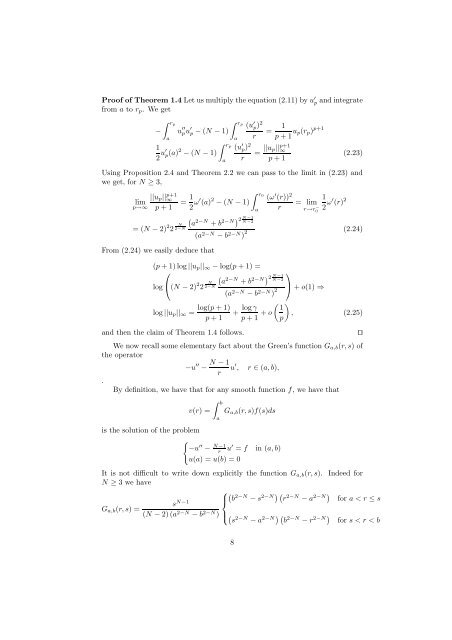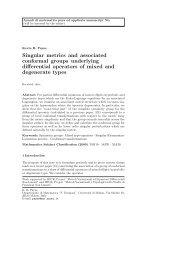Asymptotic behaviour of the Kazdan-Warner solution in the annulus ∗
Asymptotic behaviour of the Kazdan-Warner solution in the annulus ∗
Asymptotic behaviour of the Kazdan-Warner solution in the annulus ∗
You also want an ePaper? Increase the reach of your titles
YUMPU automatically turns print PDFs into web optimized ePapers that Google loves.
Pro<strong>of</strong> <strong>of</strong> Theorem 1.4 Let us multiply <strong>the</strong> equation (2.11) by u ′ p and <strong>in</strong>tegrate<br />
from a to rp. We get<br />
pu ′ rp<br />
p − (N − 1)<br />
a<br />
rp<br />
rp<br />
− u<br />
a<br />
′′<br />
1<br />
2 u′ p (a)2 − (N − 1)<br />
a<br />
(u ′ p )2<br />
r<br />
(u ′ p )2<br />
r<br />
1 p+1<br />
= up(rp)<br />
p + 1<br />
p+1 ||up|| ∞<br />
=<br />
p + 1<br />
(2.23)<br />
Us<strong>in</strong>g Proposition 2.4 and Theorem 2.2 we can pass to <strong>the</strong> limit <strong>in</strong> (2.23) and<br />
we get, for N ≥ 3,<br />
||up||<br />
lim<br />
p→∞<br />
p+1<br />
∞ 1<br />
=<br />
p + 1 2 ω′ (a) 2 r0<br />
(ω<br />
− (N − 1)<br />
′ (r)) 2<br />
r<br />
= (N − 2) 2 2 N<br />
2−N<br />
From (2.24) we easily deduce that<br />
<br />
2−N 2−N a + b N −1<br />
2 N −2<br />
(a 2−N − b 2−N ) 2<br />
(p + 1)log ||up||∞ − log(p + 1) =<br />
⎛<br />
log<br />
⎝(N − 2) 2 2 N<br />
2−N<br />
log ||up||∞ =<br />
log(p + 1)<br />
p + 1<br />
<br />
2−N 2−N a + b N −1<br />
2 N −2<br />
a<br />
(a 2−N − b 2−N ) 2<br />
⎞<br />
= lim<br />
r→r −<br />
1<br />
2 0<br />
ω′ (r) 2<br />
⎠ + o(1) ⇒<br />
(2.24)<br />
<br />
log γ 1<br />
+ + o , (2.25)<br />
p + 1 p<br />
and <strong>the</strong>n <strong>the</strong> claim <strong>of</strong> Theorem 1.4 follows. ⊓⊔<br />
We now recall some elementary fact about <strong>the</strong> Green’s function Ga,b(r, s) <strong>of</strong><br />
<strong>the</strong> operator<br />
−u ′′ N − 1<br />
− u<br />
r<br />
′ , r ∈ (a, b),<br />
.<br />
By def<strong>in</strong>ition, we have that for any smooth function f, we have that<br />
b<br />
v(r) = Ga,b(r, s)f(s)ds<br />
is <strong>the</strong> <strong>solution</strong> <strong>of</strong> <strong>the</strong> problem<br />
<br />
−u ′′ − N−1<br />
r u′ = f <strong>in</strong> (a, b)<br />
u(a) = u(b) = 0<br />
a<br />
It is not difficult to write down explicitly <strong>the</strong> function Ga,b(r, s). Indeed for<br />
N ≥ 3 we have<br />
s<br />
Ga,b(r, s) =<br />
N−1<br />
(N − 2)(a2−N − b2−N ⎧<br />
⎪⎨<br />
2−N 2−N b − s<br />
) ⎪⎩<br />
r2−N − a2−N for a < r ≤ s<br />
<br />
2−N 2−N s − a b2−N − r2−N for s < r < b<br />
8








